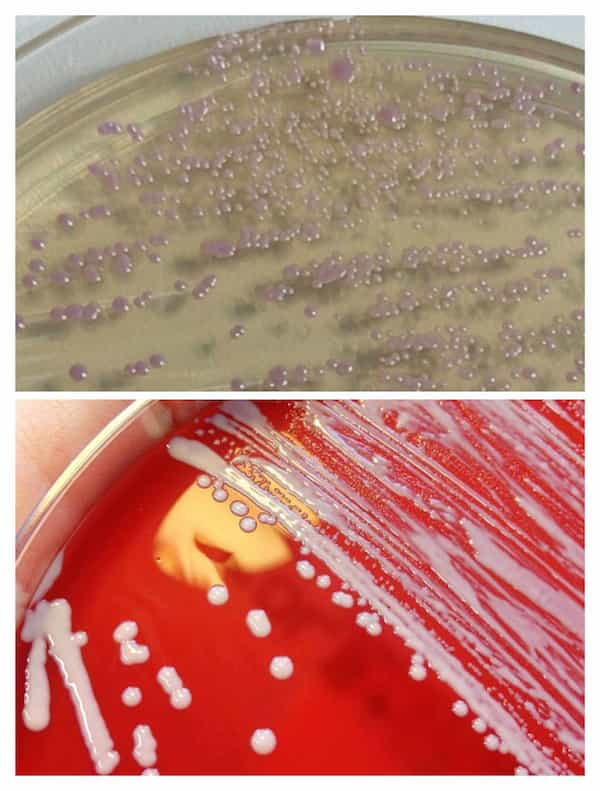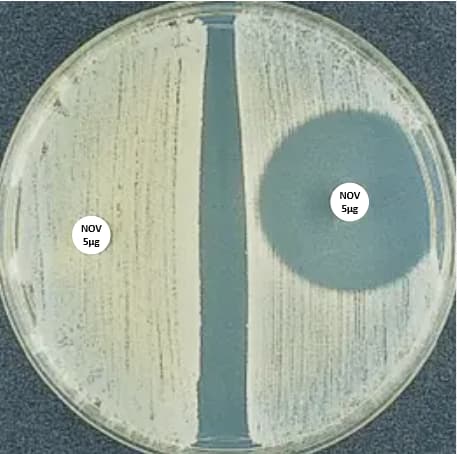Content:
◉ Introduction
Staphylococcus saprophyticus is a bacterium that is part of the normal flora, colonizing areas such as the genital tract, rectum, and gastrointestinal tract in both humans and animals.
S. saprophyticus is characterized by its ability to adhere to human urothelium, making it a frequent cause of urinary tract infections, especially in young sexually active women.
The urinary test strips may yield a falsely negative result in the case of S. saprophyticus infection (due to the absence of nitrite formation), and treatment with fosfomycin is often ineffective.
The treatment for Staphylococcus saprophyticus infection involves culturing a given sample, identifying the bacteria, and conducting an antibiogram to determine the most effective antibiotic.

Staphylococcus saprophyticus on culture media (1- chromogenic, 2- blood agar).
◉ Classification and Nomenclature
The name Staphylococcus saprophyticus was first proposed by Shaw et al. in 1951, based on the isolation of this bacterium from human urine samples.
- The genus name is "Staphylococcus", which means "grape-like cluster of cocci" in Greek.
- The species name is "Saprophyticus", which means "living on decaying matter" in Latin.
The classification of different species within the genus Staphylococci is based on a variety of factors, including morphology, chemical properties, amino acid sequences, biochemical characteristics, and nucleotide sequences.
- Domain: Bacteria.
- Phylum: Firmicutes.
- Class: Bacilli.
- Order: Bacillales.
- Family: Staphylococcaceae.
- Genus: Staphylococcus.
- Species: Staphylococcus saprophyticus.
- Subspecies: Staphylococcus saprophyticus subsp. saprophyticus
- Subspecies: Staphylococcus saprophyticus subsp. Bovis
◉ Clinical Manifestations
Staphylococcus saprophyticus is one of the main causes of uncomplicated urinary infections in sexually active young women and more rarely in young men or the elderly.
- Cystitis: It can cause a burning sensation during urination, frequent urge to urinate, blood in the urine, lower abdominal pain, and fever.
- Pyelonephritis: Less frequently, it can cause flank pain, nausea, vomiting, and chills.
- In men, S. saprophyticus can lead to urethritis, epididymitis, and prostatitis.
- Possible risk of urinary tract stone formation and experiencing renal colic episodes.
S. saprophyticus has been associated with cases of peritonitis during peritoneal dialysis, endocarditis on native valves, and nosocomial pneumonia.
◉ Identification and Bacteriological Characters
S. saprophyticus can be identified by its cultural, biochemical, and molecular characteristics. The two main features aiding in its identification are, firstly, that it belongs to coagulase-negative Staphylococci, and secondly, it exhibits inherent resistance to novobiocin.

Some of the methods used for identification include:
◉ 1- Direct examination
Staphylococcus saprophyticus is a Gram-positive cocci, non-motile, non-sporulating, usually non-capsulated with an average diameter of 0.8 to 1.2 µm. It can appear as small, round, and isolated cells or in diplococci, or in irregular clusters.
◉ 2- Culture
Like all Staphylococci, the culture of Staphylococcus saprophyticus generally poses no problem, as it has no specific nutritional requirements. It can be cultivated in a facultative aerobic-anaerobic atmosphere, on simple, enriched, chromogenic media, or on selective agar for staphylococci.
The appearance of colonies can vary from one culture media to another; typically, colonies appear round, convex, opaque, white, and somewhat creamy after 18 hours at 37°C, with a diameter of 2 to 3 mm.
- Blood agar (BA): Creamy bright white non-hemolytic colonies.
- Mannitol salt agar (MSA): Staphylococcus saprophyticus grows in this highly salted medium by fermenting mannitol, resulting in yellow colonies.
- Baird Parker agar:
- Chromogenic medium: Staphylococcus saprophyticus exhibits a distinctive color, which depends on the specific agar used.
◉ 3- Identification of the genus Staphylococcus
The genus Staphylococcus comprises Gram-positive cocci bacteria that are catalase-positive and oxidase-negative, and non-demanding. These characteristics allow differentiation from bacteria of the genera Streptococcus, Enterococcus, and Micrococcus.
◉ 4- Identification of the staphylococcus saprophyticus species and biochemical characterization
Identifying the species Staphylococcus saprophyticus and differentiating it from other species is essential, especially in cases of urinary tract infections.
Staphylococcus saprophyticus belongs to the group of coagulase-negative Staphylococcus. That's why the initial test to perform is aimed at eliminating Staphylococcus aureus, such as the coagulase test, DNase test, or agglutination test.
- Mobility: Generally non-motile.
- DNAse test: Negative (-).
- Coagulase test: Negative (-).
- Catalase test: Positive (+).
- Oxidase test: Negative (-).
- Nitrate reductase: Negative (-).
- Alkaline phosphatase: Negative (-).
- PyrA: Negative (-).
- Arginine Dihydrolase (ADH): Positive (+).
- Ornithine Decarboxylase (ODC) : Negative (-).
- Voges-Proskauer (VP) test: Positive (+).
- Sorbose Utilization: Negative (-).
- Urease test: Positive (+).
- Maltose test: Positive (+).
- Lactose test: Positive (+).
- Trehalose test: Positive (+).
- Mannitol test: Positive (+).
- Sucrose test: Positive (+).
For more complete biochemical identification, biochemical galleries such as Api 20 staph or bacteriological identification automates (MicroScan WalkAway plus System, ALFRED 60/AST.. ) can be used.
◉ 5- Antibiotic resistance profile
S. saprophyticus has intrinsic resistance to novobiocin and fosfomycin, which can help detect it from other species.
◉ 6- Molecular diagnosis
PCR (Polymerase Chain Reaction)
PCR can be used to identify S. saprophyticus by targeting its 16S rRNA gene. This gene has a unique sequence that can be distinguished from other staphylococci through the use of specific primers.
RFLP (Restriction Fragment Length Polymorphism)
RFLP can be employed to identify S. saprophyticus by utilizing a restriction enzyme that cuts the S. saprophyticus DNA into a distinctive pattern of fragments. These fragments can be separated through gel electrophoresis and compared to those of other staphylococci.
◉ Resistance
Staphylococcus saprophyticus is naturally resistant to nalidixic acid, fosfomycin, novobiocin due to a mutation in the GyrB subunit of DNA gyrase, and to fusidic acid due to the presence of the chromosomal gene fusD, encoding a protein that protects the elongation factor G.
◉ Conclusion
In conclusion, Staphylococcus saprophyticus poses a significant health concern, especially for young women with urinary tract infections. By enhancing our understanding of this bacterium and implementing preventive measures, we can strive to reduce the burden of Staphylococcus saprophyticus infections and improve patient outcomes.